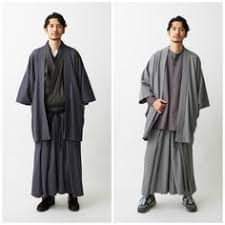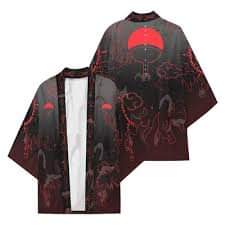What is Japanese Haori fashion?
Haori is a standard Japanese long jacket with swinging sleeves. Japanese Haori is an immaculate blend of ritual and fashion as well. Japanese Haori is obtainable in different materials and designs.
It is easy to wear an outfit and you can also carry it with other outfits. Haori is worn by men and women are common.
Japanese Haori is used for ceremonial pursuit, used to insulate against cold. In the Sengoku epoch around the 16th century, it was worn by warriors or Samurai fighters for safety against bad weather. It was popularized among women by geisha.
Geisha wore Japanese Haori as a trendy item. In the 18th century, it became common among people, and people commenced to wear it at different occurrences.

Haori from traditional to Haori sweeter
The Haori was just made for protection against cold weather so in this manner, the Japanese Haori sweater you can say is also a traditional item not modern. Due to the time gap, there may be a little change in design and fashion, but the Haori sweater is the same as the Traditional Haori.
The Sweater Japanese Haori is a casual look with different patterns or designs.
Japanese Haori sweaters are designed in that manner, letting pass ventilation to support the winter.
Details and Care
- Only wash with hands
- Do not bleach
- Ironing: maximum 30 degree
- Wash with the same color clothes
- Use the hanger to dry naturally
Measure
Available in different sizes like S, M, and L size.
Japanese Haori coat
Japanese Haori coats are adaptable and usually made with dynamic colors. These are also made with different textiles. Haori is an outfit that can be appropriate for everyone or you can carry a belt with it to make it fit according to your size.
Details and Care
- Don’t use washing power directly for washing.
- Do not wash it in the washing machine.
- Wash with the same color dresses.
- Do not spin.
Measure
All sizes which you want, you can get.
Japanese Haori jackets
Extravagant Japanese Haori jackets have been worn in Japan and china for centuries; you can say that it is an inheritance of Japanese people that they got from their ancestors. Now Japanese Haori is not only a legacy but also a style trend with multiple outfits.
Details and care
- Made with polyester fiber
- Made with leather
- Made with Pure silk
- Always care while you are washing Japanese Haori jackets
- Do not rub too much
Measure
Any size you can carry but Medium is good for everyone
Custom Japanese Haori
You can get custom Japanese Haori in sleeveless and with sleeves. Sleeveless is perfect to wear with any jacket or any inner wear skirt. This Custom Japanese Haori has no openings under the armpit. Women have openings under the armpit. This is traditional Haori made to your measurements.

Details and Care
- Wash like other Haori as we mentioned above
- Available in fine cloth
- All weather stuff
- Wash with normal water.
Measure
Could be adjustable for any size.
Dissimilar patterns of Japanese Haori
- Demon slayer Nezuko Japanese Haori pattern
- Tanjiro Japanese Haori Sweeter
- Tanjiro Japanese Haori crochet pattern
- Zenit Japanese Haori pattern
- Tanjiro blue Haori pattern
- Tanjiro Haori Pattern
- Demon slayer Nezuko Japanese Haori pattern
The Demon Slayer Nezuko Japanese Haori pattern is a very popular and traditional design of Japanese Haori. Demon slayers have hidden meanings. It is set in the early in twentieth- century in Japan.
They are worn by Sanjuro, Zenitsu, Mizuko, and Inosuke; this design is traditional, and Japanese Haori makers have used it for several centuries. This special diamond Japanese Haori design is called’’Wagara’’.
It is also in a nature-inspired pattern, the shape of overlapping hemp leaves.
This pattern is usually used for babies and children because hemp leaves are known to be durable-and fast growing. It is believed that the hemp leaves cloth will protect the wearer from misfortune and help the child to grow strong and healthy.
2. Tanjiro Japanese Haori Sweeter
Tanjiro Japanese Haori sweater with black and green ichimatsu pattern. This pattern is the combination of triangles and square shapes in alternating colors and checkered patterns. It was popularized by kabuki actor sanogawa ichimatsu.
This beautiful pattern thrives in business, longevity, and personal and familial prosperity. Tanjiro, a Japanese Haori Sweeter, also took inspiration in the Olympic and Paralympics games from Sanogawa ichimatsu. With 3 quadrilateral shapes of ideology, cultures of different countries are represented. It is also the very traditional pattern of Japanese Haori. The combination of 3 shapes represents unity and faith.
3. Tanjiro Japanese Haori crochet pattern
If you are a demon slayer fan then this pattern is for you. Tanjri Japanese Haori is made by connecting individual squares of green and black color. It is similar to Tanjiro Japanese Haori Sweeter. Sometimes these patterns come in very lightweight stuff and sometimes in heavy stuff.
4. Zenit Japanese Haori pattern
It is also a nature-inspired pattern. This pattern combines overlapping patterns equilateral. The triangles in the Zenit Japanese Haori pattern triangles resemble the scale found in snakes.
It is believed that the pattern had the powers to protect against curses and evils, that’s why it is used as burial goods that it would protect in the afterlife and also used on armor and weapons.
During the Muromachi period, this pattern can also be seen in theaters by the women or actors who perform the character of snakes or demons.
It is believed that this pattern is a prayer for safety at sea.

5. Tanjiro blue Haori pattern
Tanjiro blue Haori pattern is one of the traditional Japanese Haori patterns. It is usually in a blue sky pattern with clouds with a natural sky blue look. In this pattern, there are wind waves and white clouds in the sky. It represents the beauty, calmness, and peace above the sky.
Tanjiro Haori Pattern
Tanjiro Haori pattern is much similar to Demon slayer Nezuko Japanese Haori pattern, but it is a little bit different in this pattern. There is little depth added to the Tnajiro Japanese hair pattern.
Squares and triangles of black and green and often in yellow color are connected.
The hidden meaning of the pattern is to show equality in society.
Season wear Haori guide
Haori wearing is a style now as you can see there are lots of functional Japanese Haori divergences now. People like to wear Haori with any outfit in any season. A Japanese Haori comes in all sorts of stuff and patterns. You can choose the Japanese Haori from Japaneseonimasks.com, based on the season.
Haori is for every season pivoting on the cloth in which a Haori is made like Haori for summer should be in cotton cloth, and Japanese Haori for winter must be made in polyester wool. Go for floral spring, bright colors in spring, bliss, grays in winter, and earthier tones for the fall season.
You can also use silk fabric to make your Japanese Haori or you can buy it. Japanese Haori is now specially organized for all seasons with mixed clothing.
Japanese Haori on a Budget: Our Best Money-Saving Tips
As we noted, Japanese Haori is not only a traditional wear outfit but also people of Japan and out of Japan wear Japanese Haori as a fashion.
Here are some money-saving Tips for which you can get a Japanese Haori on an allotment.
- You can make your Japanese Haori at home, for this you can use any fabric you have at home.
- With proper care, you can last your Haori for several years.
- If you don’t want to spend too much on Haori, pre-loved Japanese Haori is also available.
- You can turn any of your pre-used dresses or coats into Japanese Haori.
- With new designs and patterns, an old Japanese Haori could be made like a new one.
- You can get Haori on rent for a day.
The Connection between Japanese Haori and Happiness
From the Taisho prewar period, women started to attend social events such as tea ceremonies, marriage parties, kabuki reunions, Haori was the formal dress of men, and ‘’going out wear for women’’.
Japanese not only feel traditional but also feel comfort and happiness in Haori. In every culture, the cultural heritage appeals to people, and people love to be traditional, in the same manner, the Japanese feel love and joy.
Several ways in the world to cheer up and Japanese Haori wearing is one of them.






